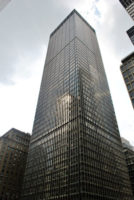Some may remember architect and artist Jorge Otero-Pailos writing in these pages that “our profession’s current commitment to preservation will most likely not last long.”
Six years later, his outlook seems less pessimistic: Otero-Pailos, who holds a B.Arch. from Cornell and a Ph.D. from MIT, was in January of this year named director of the first U.S.-based doctoral program exclusively focused on historic preservation. Offered at Columbia’s Graduate School of Architecture, Planning and Preservation, where Otero-Pailos has taught and directed the master’s program in preservation, the Ph.D. program will begin in fall 2018. RECORD spoke with Otero-Pailos by phone about his new role and the future of the field.
Architectural Record: What changed your mind about the profession’s commitment to preservation?
Otero-Pailos: I was imagining that as the economy picked up, architects would lose interest in preservation. But it’s stronger now than it was then, partly because something fundamental has changed in America in the interim. If you ask yourself where American culture was debated last year, we can look to existing monuments, like the Robert E. Lee statue in Charlottesville, rather than museums or new buildings. For the new generation, preservation is now one of the defining areas of practice where the future of culture and politics is at stake.
How did the Ph.D. program come about?
We felt a very strong need to educate the professors as well as practitioners of the future. A lot of organizations (including UNESCO, NGOs, or museums) hire preservationists to conduct research or advance experimental practice. But many schools only hire preservationists with Ph.D.s. There was a real need to have discipline-specific scholarship and training for the next generation of teachers.
What is the general level of expertise of architects practicing preservation in the U.S.?
It’s quite limited in areas of research and scholarship. Practitioners often adopt materials and techniques promoted by companies, which haven’t been truly tested. There’s also very little development of new technologies in America—almost zero. Most of the research that we have is being done by independent practitioners without any institutional support.
What new technologies are springing up?
We are seeing the development of biotechnology, such as using bacteria to clean structures rather than mechanical devices. The other major revolution is in neuroscience; preservation is so much about people’s emotions and memories, and neuroscience is transforming the way we think of the relationship between landmarks and people.
What do you think the future of the field holds?
Much of the architecture constructed after World War II was not built to last more than 50 years. As structures become technologically obsolete, we are faced with a question: do we demolish or do we reuse? We don’t have the energy to demolish and reconstruct everything, but we also can’t treat all of it as a work of art. We have to make different kinds of choices, and those require different kinds of theoretical approaches that need to be developed by scholars.
For example, look at what happens to most of the skyscrapers in New York City, especially the ones that have proper curtain walls: their facades are eventually removed and replaced with something that looks more or less like them. With 3-D scanning and printing, and automation or robotics, the whole process of reskinning buildings or doing spot repairs might completely change. We need a new generation of people who can think through these problems—because they’re the ones who are going to have to live with the consequences.






Post a comment to this article
Report Abusive Comment